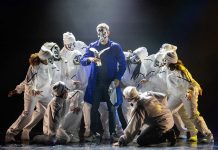Directed by Jamie Lloyd, the stage, for this outdoor presentation of Tim Rice and Andrew Lloyd-Webber’s classic musical can be summed up in one word: steps.
The 18-piece orchestra and both sound and lights made us almost forget about the wind and rain that threatened to destroy the evening’s ‘summertime’ events.
The 18-piece orchestra – led by MD Alan Williams – and both sound (Nick Lidster) and light design (Jon Clark) made us almost forget about the wind and rain that threatened to destroy the evening’s ‘summertime’ events. Again, however, there is no song – or motif – that conjures up the South American Latin fire that must have been present in 40s and 50s Argentina. There is no ‘America’ – heck, there isn’t even a ‘Somewhere’.
The musical – and emotional – standout is ‘Another suitcase in another hall (what happens now?)’. Sung and performed beautifully by Frances Mayli McCann, the song – from the mouth of Juan Peron’s Mistress – is a glorious examination of the heartache that comes with being ‘the other woman’. Its power comes primarily from the lyric’s emotional specificity, as well as from the character’s transparency. There is no other song in the rest of the musical that compares emotionally to this moment.
Of course, the ubiquitous ‘Don’t cry for me, Argentina’ -with its many reprises – tries hard, but the (admittedly beautiful) melody often gets bogged down by lyrical overload, and fails to have the impact it should.
This signifies a significant flaw in the presentation of the main character. Sadly, in a musical named after her, we come away not really knowing much about Evita’s inner-life – only the main aspects of her historical time-line.
We certainly don’t get to feel the chemistry between Evita and Juan Peron. Significantly, the main actors barely move/dance together; instead, two ‘surrogate’ dancers are often tasked with physicalizing the (assumed) love between the pair. It is left, then, for the main duo to communicate their chemistry through acting and singing; something they do only in fits-and-starts.
Furthermore, we barely get to see Evita engage with her fellow Argentineans in a way that would imply the ‘unbreakable bond’ between her and ‘the people’, or her (very real) status as a proto-feminist activist. Instead, we are merely treated to moments – shown by parts of the ensemble – wherein ‘the elite’ show their disdain for her, before (it is presumed) being dismantled and/or removed.
There are certainly some interesting set pieces. ‘The art of the possible’ – with a fabulously sinewy solo dance that uses hip-hop, contemporary, vogue, tutting and locking to counterpoint Evita’s burgeoning social ambitions – is a choreographic highlight; one that fully complements the narrative, without feeling tied to it.
‘Dice are rolling’ is also superb; a tightly choreographed piece where – finally – the dancers get to utilize the stairs in a practical and interesting way. Here, they roll up – then down – in support of the narrative, pair off in homage to the earlier tango duet, and generally create a sense of tightly sequenced urgency sadly lacking in the main duo’s chemistry.
Sadly, in a musical named after her, we come away not really knowing much about Evita’s inner-life
Even ‘Che’ – the ‘audience surrogate’ – performed with intensity, skill and commitment by Trent Saunders – cannot help us get into the mind, soul or spirit of the main character; and so, she remains, until the final anticlimactic denouement, unknowable, aloof, iconic…like a beautiful silhouette, created in the image of a once-live human being.
On the face of it, the constant re-working of this musical makes sense within a modern political and social climate. Ostensibly, it is the tale of an ambitious, charismatic celebrity who becomes – despite opposition from orthodox forces – a national and international icon through politics (Trump); it is about a woman who displays tenacity and ambition to learn from and supersede the men in her life/existing patriarchy (Madonna); it is also about the ‘cult of personality’, and how easily ‘our’ need for ‘identifiable saviors’ can turn models into ‘role models’, actors into political activists, singers into ‘pied pipers’, and messengers into martyrs. It’s also a reminder how ‘our’ desire for easily digestible (and recognizable) narratives often makes us throw our lot in (wholesale) with those who make us invest / divest the most.
The story has a great deal going for it: one woman’s fight from poverty in 40s Argentina, women’s rights issues, a central love-story, and a backdrop of national poverty and international war. Unfortunately – as it doesn’t possess sufficient ‘musical highlights’ or emotional hooks – this musical, that once (I’m sure) seemed timeless, seems quite dated.
Indeed, with this modern iteration having taken such (presumably post-modern) ‘steps’ to dissemble Evita’s various components, it appears to have gotten even more so.
Still, thankfully the rain held off.



























